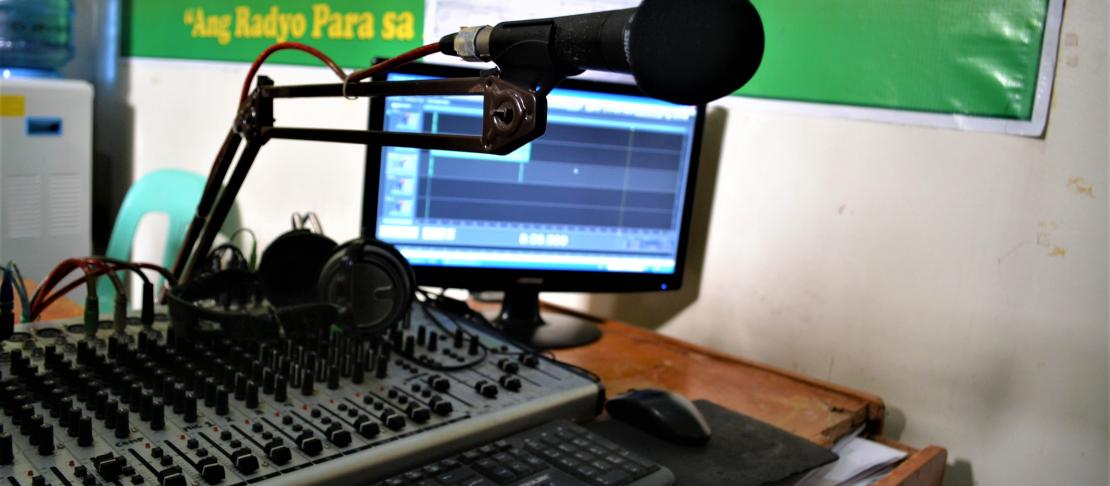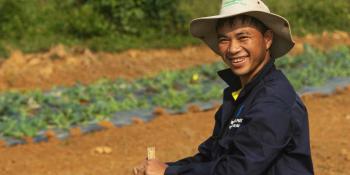Workshop for Philippine rural broadcasters about climate change and its impacts

The challenge for rural broadcasters today is to produce relatable and engaging contents about climate change for their audience.
The Philippine Federation of Rural Broadcasters (PFRB) and the CGIAR Research Program on Climate Change, Agriculture and Food Security in Southeast Asia (CCAFS SEA), together with the Department of Agriculture-Agricultural Training Institute (DA-ATI), continue to engage with rural broadcasters in the Philippines to enhance their understanding of climate change and the corresponding adaptation and mitigation measures in agriculture that they must communicate to vulnerable communities.
PFRB, CCAFS SEA and DA-ATI co-organized three broadcast production workshops in Echague, Isabela; Baybay, Leyte; and Cagayan de Oro, Misamis Oriental, which were attended by rural broadcasters in the respective provinces, experts on climate change, and local farmers who shared their experiences amid the current climate conditions. The presentations of the experts and the testimonials of the farmers provided valuable insights to the broadcasters about the issue of climate change. CCAFS SEA and PFRB then shared ideas on how to popularize climate change and its impacts in order to mobilize people in their areas.
Dr. Rogelio Matalang, PFRB President, told the broadcasters to “be you; be true; [and] be new.” This means that as they go on air, they must build an identity that is relatable and “reachable” by their target audiences. Such identity shall catch the audience’s attention. To turn this attention into concrete climate actions, rural broadcasters must air short, but attractive messages that can compete with the various forms of entertainment being consumed across all media platforms today.
Dr. Rex Navarro, CCAFS SEA Consultant and PFRB Adviser, echoed the words of Dr. Matalang, then added that a multi-media approach must be adopted not only to communicate climate messages, but also to reach a critical mass of audience that will be mobilized in climate actions. All these efforts require strong political support. He advised the broadcasters and the other participants to work closely with the Department of Agriculture (DA) as they strive to achieve a climate-resilient and low-emissions agriculture sector.

Why should climate change be a concern to the farmers?
Dr. Navarro shared with the participants that the increase in frequency and intensity of extreme weather events has already led to massive losses and damages in agricultural production. The extreme weather events, as well as sea level rise, droughts, and rising temperature are all manifestations of climate change in the Philippines.
The root cause of climate change is excessive amounts of greenhouse gases (GHGs) being emitted into the atmosphere. The agriculture sector alone emits large amounts of nitrous oxide, methane, and carbon dioxide through irrigated rice production, livestock raising, and biomass burning, among others. If these farming activities continue under a business-as-usual approach, 2050 projections show a catastrophic scenario for farmers, who belong to the most vulnerable—and in the case of the Philippines, the poorest—sectors of the society.
Climate-smart agriculture (CSA) is now viewed as a key solution for this problem. CSA is an approach to “transform and re-orient” agriculture, aiming to increase the productivity of the sector while enhancing its climate resilience and reducing its GHG emissions. How can then CSA transform from an abstract concept into a concrete solution?

The role of radio in bringing climate actions to vulnerable communities
Radio addresses time, spatial, language, and other socio-economic barriers that could impede CSA adoption. It could deliver key climate advisories and forecasts that could prepare the farmers for an upcoming natural disaster. If integrated into a school-on-the-air (SOA), the radio can serve as a platform where farmers not only learn about climate change, but also the appropriate CSA technologies and practices that they can adopt it their farms.
CCAFS SEA, together with PFRB, DA Regional Field Office 2, and the Philippine Rice Research Institute (PhilRice), published a manual on how to establish a SOA program. A SOA-on-CSA program titled, “Kaalamang Pagsasaka sa Himpapawid: A School-on-the-Air Project on Climate-Smart Agriculture in Cagayan Valley” was launched this year. This program serves as a pilot case study that shows how radio can deliver climate services to vulnerable communities. To establish such a program, government agencies, the media, the academia, the private sector, and other key actors must work together and call for the active participation of their target audience; the farmers.
Read More:
- Blog: Communicating climate-smart agriculture via School-on-the-Air
- Book: Klima 101: A Climate Change Guidebook for Philippine Journalists
- News Update: Climate-smart farmers in Cagayan Valley, Philippines graduate from school-on-the-air program
- News Update: Linking knowledge with action: The role of media in climate change adaptation and mitigation
Renz Louie Celeridad is the Junior Communications Specialist for the World Agroforestry Centre Philippines. He also works as a Communications Consultant for CCAFS SEA.



